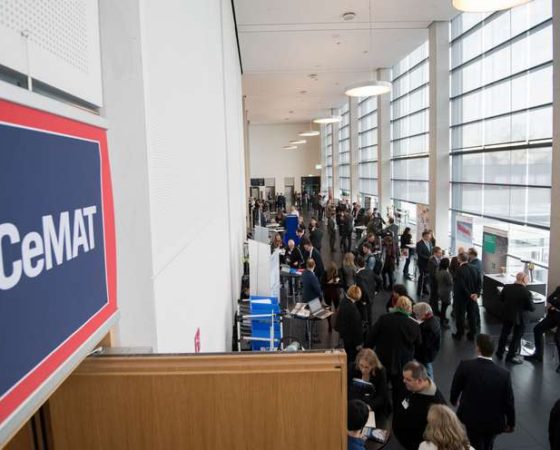The future of intralogistics is digital and networked. The VDMA Materials Handling and Intralogistics Association and the VDMA Software and Digitalization Association support the forum program at CeMAT 2018. Together with important partners the VDMA associations show which trends and technologies make Logistics 4.0 possible.
VDMA forum program for materials handling and intralogistics as well as software and digitalization
Hannover. The VDMA Materials Handling and Intralogistics Association and the VDMA Software and Digitalization Association support the forum program at CeMAT 2018. Together with important partners such as the German Logistics Association (BVL), the Fraunhofer Institute for Material Flow and Logistics IML, the EHI Retail Institute and the Scientific Society for Technical Logistics (WGTL) the VDMA associations show which trends and technologies make Logistics 4.0 possible.

The future of intralogistics is digital and networked. Various products are already developing strongly towards autonomous intelligent systems. Automated guided vehicles and systems are already part of the familiar picture in warehouses and production facilities worldwide. New methods of navigation and increasingly sophisticated sensor technology ensure efficiency and process automation in production and warehouse logistics worldwide. What benefit do they offer users? What technical innovations and enhancements are there? Research experts, users and manufacturers will answer such questions at the CeMAT Logistics Solutions Forum in Hall 21.
The vision of self-optimizing intralogistics solutions requires further research and development. Together with the Fraunhofer Institute for Material Flow and Logistics IML, the VDMA Materials Handling and Intralogistics Association has developed three technology roadmaps for Intralogistics 2025. The results, which include recommendations for action in the fields of sensor technology, communication and data science, will be presented and discussed in Forum Logistics 4.0 in Hall 19.
Other aspects of digitalization relate to the processes within supply chains. Blockchains could be crucial to digitally networking all participants in a supply chain. Transparency, process and manipulation security are essential advantages of the technology. Nevertheless, many questions remain unanswered: For which logistics applications are blockchains suitable? When is the right time to deal with this topic? How do you approach the introduction? Which legal and technical challenges still need to be clarified? The VDMA Association of Materials Handling and Intralogistics and experts will discuss such topics at the Forum Logistics 4.0.
Machine learning, digital twin and IT platforms are making their way into logistics
New digitalization technologies such as IT platforms, machine learning and digital twin expand the horizons of the logistics world in many user industries. Thanks to the constantly improving technology, it is possible to optimize all processes of the value-added chain and thus to work even more effectively and cost-efficiently. Thanks to intelligent networking between production and logistics, information can now be delivered both internally and externally for processes and products.
Large amounts of data and the sharp increase in computing power provide the optimal framework for machine learning applications in the environment of Industrie 4.0, enabling much previously unused information to become part of the value-added chain and contribute to the digital transformation of companies. Platforms will also increasingly dominate the logistics market. Many providers and users ensure that digital platforms regulate the market, reduce transaction costs and play a key role in redistributing value creation. Digital twin solutions also allow different perspectives in logistics. The digital twin is in constant interaction with its partner. It records the individual levels of the lifecycle and analyzes them. The advantage: Observations and sensor data from ongoing operations flow back into the model in real time and can be used for continuous optimization and updates.
In the forums in Halls 19 and 21, visitors will learn which challenges companies have to master with these technologies and how to manage logistics in the digital fast lane.
The VDMA program at a glance:
Monday, April 23, 2018
Technology Roadmaps Intralogistics 2025
3:00–4:00 p.m., Forum Logistics 4.0 in Hall 19
Tuesday, April 24, 2018
Digital Twin
10:00 a.m.–12:00 noon, Forum Logistics 4.0 in Hall 19
Driverless and autonomous into the future
10:00 a.m.–12:00 noon, Logistics Solutions Forum in Hall 21
IT Security
3:00–5:00 p.m., Logistics Solutions Forum in Hall 21
Wednesday, April 25, 2018
Identification / Traceability
1:00–3:00 p.m., Logistics Solutions Forum in Hall 21
Blockchain – the digital turbo for logistics?
3:00–5:00 p.m., Forum Logistics 4.0 in Hall 19
Thursday, April 26, 2018
Use of IT platforms in the supply chain
10:00 a.m.–12:00 noon, Forum Logistics 4.0 in Hall 19
Artificial Intelligence in the Supply Chain
3:00–5:00 p.m., Forum Logistics 4.0 in Hall 19
Your contact for further information:
VDMA Materials Handling and Intralogistics Association
Juliane Friedrich
Tel.: +49 69 6603-1508
E-mail: juliane.friedrich (at) vdma.org
forrás: cemat.de 2018.03.09
címfotó: Deutsche Messe

